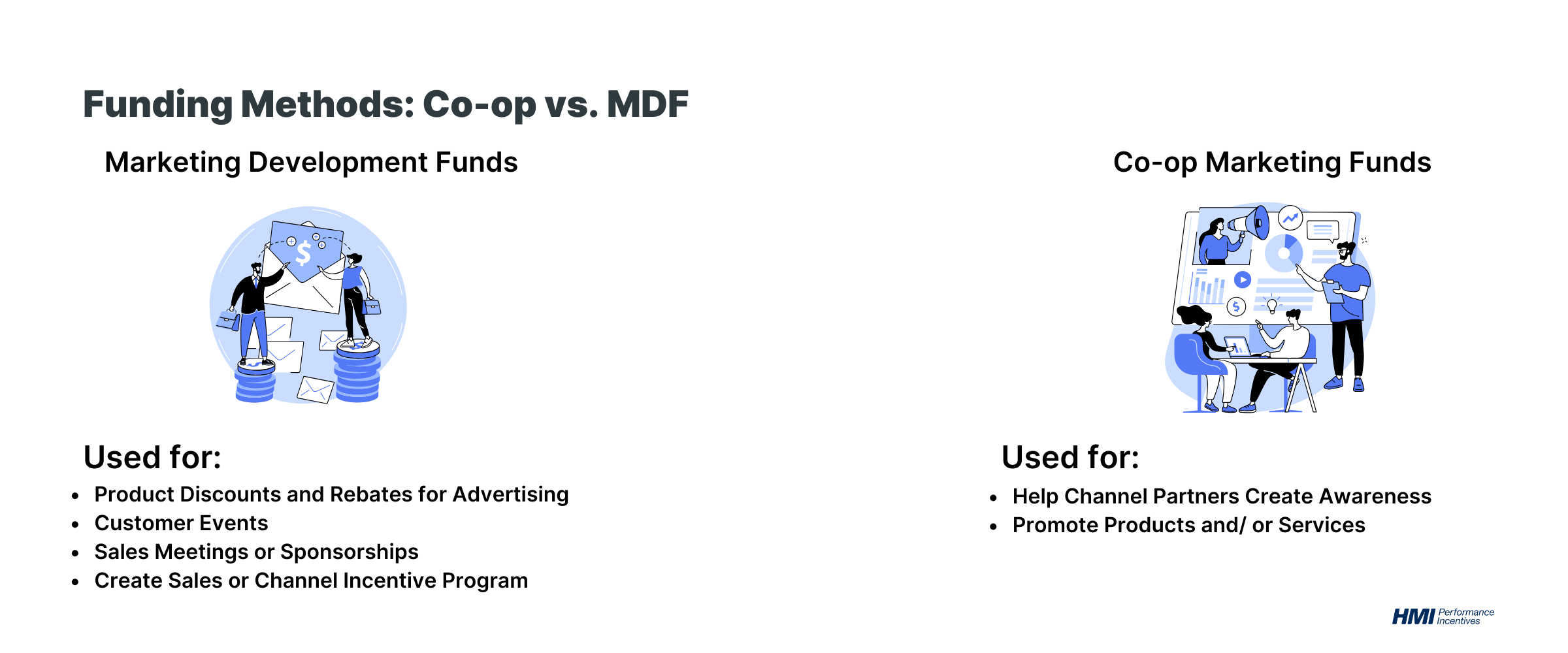Let’s face it. Marketing campaigns aren’t cheap – even if you use co-op or market development funds (MDF).
The Incentive Research Foundation (IRF) estimates incentive programs can cost $4,000/person. One IRF study found 60% of respondents believe costs are rising faster than budgets. That means rising costs are still one of the top constraints for incentive programs.
But distributors who are intentional can get the most out of their marketing budgets.
This often means leaning on two alternative funding resources – co-op and MDF funds. Depending on your channel goals, these resources may support your marketing needs. Let’s dive in and learn a little more about each one.
Alternative Funding Method #1: Market Development Funds
A market development fund (MDF), in simple terms, is a co-investment in marketing. MDFs help vendors and manufacturers penetrate new markets and create brand awareness. They also strengthen and support channels via marketing activities to sell products.
Vendors invest between 1% – 2% of top-line revenue to these funds. This budget gets used in any number of ways:
- Product discounts and rebates for advertising
- Customer events
- Sales meetings or sponsorships
One of the most effective uses of MDF funds is to create a sales or channel incentive program. Another way is to supplement an existing program.
Want to see how one company used MDF to support its incentive program? Take a look at this example. Building Loyalty: Breaking the SPIFF Mold to Increase Sales with Non-Cash Incentives.
Unfortunately, a good chunk of a vendor’s MDF often goes unused. Depending on your source this number can be anywhere from 1-25% of total MDF funds.
The reasons for this vary, but can include:
- Significant gaps between vendor processes and reseller capabilities
- Significant lag-time between dealer claim submissions and vendor reimbursements
- Complicated or restrictive guidelines and processes
- Lack of understand of which partners are best to target
Vendors must be aware of and address the above issues. Only then can MDFs be a useful way to ease incentive program budgetary concerns.
Manufacturers and vendors must shorten the time it takes to reimburse partners. Additionally, they must simplify the fund guidelines and processes. They must also provide marketing concierge services for those partners who need it. Finally, they must recognize which partners are set up and motivated to use the funds.
Only then will your MDF be fully utilized.
Alternative Funding Method #2: Co-Op Marketing Funds
Like MDFs, co-op marketing funds are often derived from 1%-2% of prior partner sales or purchases. They’re designed to help channel partners create local awareness of a national brand. Additionally, they promote the company’s products and/or services.
So how do they differ:
-
MDF – controlled by vendors. They get assigned to channel partners in anticipation of future sales projections.
-
Co-op – controlled by channel partners once they get assigned. These funds represent projections from previous sales figures.
Vendors usually have agreements in place with their channel partners. These agreements dictate the how the money gets used and have reporting protocols for when it is.
Co-op funds are “accrual-based”. They’re determined by sales history. Thus, they reinforce partner behaviors in current markets rather than predicting new ones.
This leads to more of a fixed budget. Funding becomes more predictable for channel partners. That means partners can do a better job of preparing for how to use the money.
This predictability lends itself to longer-term marketing activities. For instance, annual incentive campaigns. Because these budgets must be more-or-less fixed from the outset.
Which Method Is Right for Me?

Which alternative funding method you choose depends on what your channel looks like.
Do you have established relationships with partners that you’re looking to reinforce? Or is your market more dynamic? Are you offering new and enticing channels that you haven’t yet begun to sink your teeth into?
Are you looking to stimulate channel partner activity that doesn’t exist yet? If so, then a more discretionary MDF might be what you’re looking for.
Do you channel partners tend to be smaller? Do they lack resources to devote to complex marketing? If so, then a more reliable co-op fund may be more appropriate.
Other determining factors include whether you’re looking to use your funds for.
Do you want to create a long-term incentive program or a short-term promotion?
Are you a vendor looking to stimulate activity among your dealer networks? Or are you a distributor trying to generate funds from a series of manufacturers?
Do your channel goals include partner development and enablement?
Need more guidance to discover with funding alternative is right for you?
Click here to book a call. Together we’ll help you find solutions to improve your channel partnerships.




